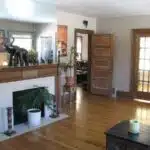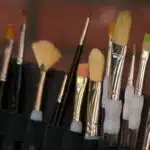Creating a visually stunning space is an essential aspect of interior decorating. The choice of color and texture can significantly impact the ambiance of a room, giving it a distinct personality that reflects the owner’s style and taste. One popular trend in interior decoration is the use of ombre walls, which gradually transition from one shade to another, creating a seamless gradient effect that adds depth and interest to any room. Painting ombre walls may look daunting, but with some preparation and patience, anyone can achieve this stylish look.
This article provides a comprehensive guide on how to paint ombre walls successfully. From selecting the right colors to preparing the surface and creating perfect transitions between shades, this article will take you through each step required for achieving beautiful ombre walls. Whether you’re aiming for a bold statement or subtle elegance, painting ombre walls can be an excellent way to add drama and personality to your living space. With our expert tips and tricks, you’ll be able to create a stunning feature wall that enhances your home’s ambiance while making your guests feel welcome and comfortable.
Choosing Your Color Scheme
Color is a powerful tool that can be used to evoke emotions and set the tone for a room. When choosing a color scheme for your ombre walls, it’s important to consider color psychology. Different colors can have different effects on our mood and behavior, so it’s crucial to select colors that align with the intended ambiance of the space. For example, blue is often associated with calmness and tranquility, while yellow is cheerful and energizing.
One effective technique for creating an ombre effect is to use complementary colors. Complementary colors are those that are directly opposite each other on the color wheel such as blue and orange, red and green or yellow and purple. When combined in the right proportions, these colors create a striking contrast that can be visually appealing. For instance, if you choose blue as your base color, then orange will be its complementary color.
It’s also essential to consider any existing décor when choosing your color scheme. If your furniture or accessories already have bold patterns or bright hues, then you might want to opt for more muted tones on your walls. Conversely, if your décor is neutral or monochromatic, then you could use this opportunity to add some pops of color through an ombre effect. By using complementary colors in harmony with existing decor elements, you will achieve a cohesive look throughout the room. Now that we’ve covered how to choose the perfect palette for your ombre walls let’s move onto gathering our painting supplies.
Gathering Your Painting Supplies
Before embarking on your ombre painting project, it is essential to gather all the necessary supplies in one place. The right tools will make your work easier and give you a more professional finish. You will need paintbrushes of different sizes, painter’s tape, sandpaper, drop cloths, a paint tray or bucket, and of course, paint.
Painting techniques are crucial in achieving a perfect ombre effect on your walls. As an interior decorator, I recommend using a blending sponge or roller for smoother transitions from one hue to another. It would be best if you also considered the direction of your brush strokes and how much paint you load onto the brush for each section. These factors will determine the depth of color and texture on your wall.
Color inspiration is key when choosing the shades for your ombre walls. Consider painting samples on paper or cardboard first to see how the colors blend together before applying them directly to the wall. You can also take cues from nature or color palettes used in other parts of your home decor. Remember that ombre painting involves several shades of the same color family; therefore, choose hues that complement each other well.
Now that you have gathered all your supplies and decided on your color scheme let’s move on to preparing your walls for painting.
Preparing Your Walls
To ensure a smooth and flawless painting process, it’s important to start by measuring your walls. This is particularly crucial when creating an ombre effect, as the gradient effect will be most visible on a wall of consistent size. Use a tape measure to get accurate measurements of your walls, and take note of any areas that might need extra attention, such as corners or edges.
Once you’ve measured your walls, it’s time to prepare them for painting. Start by filling any holes or cracks in the wall using spackle or drywall compound. This step is essential for achieving a professional-looking finish, as even small imperfections can be magnified by the gradient effect of an ombre wall. Take your time with this step and use a putty knife to create a smooth surface.
After filling any holes or cracks in your walls, it’s time to move on to taping your base color. This is the first color you’ll paint onto the wall before blending into the ombre effect. Use painter’s tape to mark out where this color will start and end on the wall, making sure to apply it evenly for a clean line. Once you’ve taped off the base color, you’re ready to move on to the next step in creating beautiful ombre walls.
Three essential steps for preparing your walls:
- Measure your walls accurately using a tape measure
- Fill any holes or cracks in the wall using spackle or drywall compound
- Use painter’s tape to mark off where your base color will start and end on the wall
As an interior decorator, I understand that creating an ombre effect on walls can seem daunting at first glance. But with careful preparation and attention to detail during each stage of the process, you can achieve truly stunning results that elevate any room in your home.
So now that you’ve measured your walls and filled any holes or cracks, it’s time to move on to taping your base color. This will be the starting point for the ombre effect and will create a clean line between colors. With these essential steps completed, you’re well on your way to mastering the art of painting beautiful ombre walls.
Taping Your Base Color
To achieve the perfect ombre wall, it is important to start with a solid base color. Before you begin painting, you will need to tape off the areas where your base color will be applied. This will ensure that the ombre effect remains clean and crisp.
When taping off your base color, it is important to use proper taping techniques. Avoid stretching the tape too tightly, as this can cause paint bleed and uneven lines. It is also important to ensure that the tape is firmly pressed against the surface to prevent any gaps or air bubbles.
Once your tape is in place, it’s time to consider color placement. Think about how you want the ombre effect to flow and where you want each shade of color to begin and end. Take into account factors such as natural lighting and room size when making these decisions. With careful planning and attention to detail during this step, you can create a stunning ombre effect on your walls.
As we move forward in this process, we will now focus on mixing our paint colors. By taking the time to carefully blend our shades, we can achieve a seamless transition from one color to another. Let’s dive into some tips for mixing your paint colors and creating a beautiful ombre wall in your home.
Mixing Your Paint Colors
Before we dive into the color mixing techniques, let’s quickly recap some color theory basics. Primary colors are red, blue, and yellow. Secondary colors are made by mixing two primary colors together: green (blue and yellow), orange (red and yellow), and purple (red and blue). Tertiary colors are created by mixing a primary color with a secondary color. For example, red-orange is a tertiary color made by mixing red and orange.
Now that we’ve got that out of the way, let’s talk about how to mix your paint colors for ombre walls. First things first, you’ll need to decide on the colors you want to use in your gradient. Consider using shades of the same hue or complementary colors for a striking effect. Once you have your colors selected, it’s time to start mixing.
One technique for creating an ombre effect is to mix your base color with varying amounts of white paint to create lighter shades as you work up the wall. Another option is to mix two adjacent colors together until they smoothly transition into each other. A third technique is to use a spray bottle filled with water to mist the wall before blending two colors together for a more subtle gradient effect. With these techniques in mind, you’re ready to start creating your first gradient without any hesitation!
Creating Your First Gradient
After mixing your paint colors, it’s time to start creating your first gradient. Before you begin, make sure you have all the necessary tools: a paint roller, painter’s tape, and a paintbrush. Start by painting the top of the wall with the lightest shade of paint using a roller. It’s best to work in small sections to ensure that the paint doesn’t dry before you blend it.
Next, use a clean brush to blend the next shade into the first one while it’s still wet. You can do this by overlapping the two colors slightly and blending them together with a back-and-forth motion. Repeat this process until you’ve worked your way down to the darkest shade at the bottom of the wall.
Blending techniques are essential when attempting ombre walls as they create a smooth transition between each color. There are several blending techniques that you can use depending on your desired effect, such as feathering or cross-hatching. Experiment with different techniques to find what works best for you and your chosen color combinations. Remember, there’s no right or wrong way to blend your colors – just have fun with it!
As an interior decorator, I recommend selecting complementary shades for an ombre effect that really pops. For example, shades of blue and green or pink and purple work great together. However, if you prefer a more subtle look, stick with shades from within the same color family such as light pink transitioning into dark rose. With these tips in mind, you’re well on your way to painting beautiful ombre walls that will add depth and interest to any room!
Blending Your Colors
Blending Your Colors:
Blending techniques are crucial when painting ombre walls. To achieve a seamless and smooth gradient effect, it is important to blend your colors properly. One of the most effective blending techniques is wet-on-wet blending. This technique involves applying one color while the previous layer is still wet. This allows for a smoother transition between colors and creates a more natural effect.
It’s also essential to pay attention to color transitions when blending your colors. Start with the lightest color at the top of the wall and gradually move down to the darker shade at the bottom. To ensure that you have a gradual transition, blend each layer carefully before moving on to the next one. If you’re not satisfied with how your colors are blending, don’t be afraid to go back and apply additional layers until you’ve achieved your desired look.
Remember that practice makes perfect when it comes to blending techniques and color transitions. Take your time, experiment with different techniques, and don’t be afraid to make mistakes along the way. The key is to be patient and persistent until you achieve the perfect ombre effect on your walls.
As you continue painting, periodically step back and check your progress from a distance. This will give you a better perspective on how well your colors are blending together and whether or not adjustments need to be made. When checking your progress, keep in mind that small imperfections can often be overlooked once the entire project is complete. So don’t stress over minor flaws – just enjoy the process of creating a beautiful ombre wall in your home!
Checking Your Progress
Did you know that measuring progress is an essential part of any DIY project? This allows you to see whether you are on the right track or if changes need to be made. When painting ombre walls, it is crucial to check your progress regularly to achieve a seamless gradient effect.
To measure your progress, step back and look at the wall from a distance. This will give you a better perspective on how the colors blend together. If you notice any areas that need improvement, don’t worry! Troubleshooting mistakes is all part of the process. Here are some common issues that may arise when painting ombre walls:
- Uneven blending: To fix this, use a dry brush to soften the transition between colors.
- Harsh lines: Use a damp sponge or cloth to blend the colors together and create a more gradual transition.
Remember, practice makes perfect. Don’t be discouraged if your first attempt isn’t flawless. With each stroke of the brush, you’ll become more confident in your technique.
As you continue painting, keep an eye on your progress and adjust your technique as needed. This may mean using less paint for a softer effect or applying more pressure for a bolder look. By taking these steps, you’ll be well on your way to creating beautiful ombre walls that will impress anyone who walks into your home.
Adjusting Your Technique
To achieve a flawless ombre wall, adjusting your brushstrokes and blending techniques is essential. First, you need to make sure that the paint on your brush is evenly distributed. You can do this by loading up your brush with paint and then scraping off any excess. This will prevent drips and ensure that the transition between colors is smooth.
When transitioning from one color to another, it’s important to use a blending technique that creates a seamless gradient. Start by brushing the first color onto the wall in long strokes. Then, dip your brush into the second color and start brushing downwards from where the first color ends. Use light pressure at first until you get a feel for how quickly the colors blend together.
Adjusting your technique as needed will be necessary depending on the type of paint you are using and the desired effect you want to achieve. For example, if you’re using a thick paint, you may need to apply more pressure when blending to get a smooth transition. Alternatively, if you’re using a thinner paint or working with an intricate design, you may need to use smaller brushes and take your time with each stroke.
With these adjustments made, you can move on to painting your final gradient. This is where all of your hard work pays off! By following these techniques and making adjustments along the way, you’ll have created an ombre wall that looks professional and stylish.
Painting Your Final Gradient
Now that your base coat has completely dried, it’s time to paint the final gradient. To achieve a seamless ombre effect, you need to use a blending technique while transitioning from one color to another. Start by dipping your brush into the lighter shade of paint and make a line across the wall where you want the color transition to begin.
Next, dip your brush into the darker shade of paint and blend it with the lighter shade by painting over the line you created earlier. Use long strokes in an up-and-down motion to create a smooth transition between colors. Keep adding more of the darker shade until you reach your desired level of contrast. Make sure to blend thoroughly to avoid any harsh lines or uneven patches.
Continue this process until you have painted all of your gradient sections. Take breaks as needed, but try not to let each section dry completely before blending in the next color. Remember, achieving a perfect ombre effect takes patience and practice. Once you’re finished with all sections, step back and admire your beautiful new walls with flawless color transitions!
Now that your final gradient is complete, it’s time to remove any tape you may have used during the painting process. Carefully peel off the tape at a 45-degree angle for clean edges without pulling off any paint. Take your time and be gentle as removing tape too quickly can cause uneven lines or remove some of your hard work. With this step completed successfully, you’re ready to enjoy your stunning new ombre walls!
Removing Your Tape
- Prior to removing your tape, be sure to ensure the paint has completely dried and the wall surface is clean and dry.
- To remove the tape, use a gentle motion, starting from the top and slowly working your way to the bottom of the wall.
- Avoid the temptation of simply ripping the tape off quickly, as this can cause paint to peel and damage the wall.
- Once the tape has been removed, if necessary, it can be reapplied to the same area in order to create the desired ombre effect.
- When reapplying the tape, be sure to apply it in a straight line, and firmly press the edges of the tape down to ensure a tight seal.
- Finally, take the time to inspect the edges of the tape to ensure there are no gaps that could lead to paint bleeding through.
Preparing For Removal
Removing your tape after painting an ombre wall can be both exciting and overwhelming. You’ve put in the time and effort to create a beautiful gradient effect, but the last thing you want is to ruin it by peeling off the tape incorrectly. As a professional interior decorator, I suggest taking the necessary precautions to ensure that your hard work pays off.
Before you begin removing your tape, make sure to remove any wallpaper or residue on the walls. Any remaining adhesive can cause the paint to peel off with the tape, ruining your ombre effect. Next, patch any holes or dents in your wall with spackle or joint compound. This will prevent any unwanted lines or textures from appearing once you remove the tape. Once your walls are clean and smooth, you’re ready to take off the paint.
To avoid damaging your newly painted ombre wall, use a sharp utility knife to cut through the paint along the edges of the tape before peeling it off. Be sure to pull the tape slowly and at an angle towards yourself for a clean removal. If you notice any sections of paint lifting with the tape, stop immediately and use a razor blade to carefully cut around those areas before continuing. With these steps, you’ll have perfectly crisp lines on your ombre wall without any unwanted blemishes or mistakes.
In conclusion, removing your tape after painting an ombre wall requires patience and attention to detail. By properly preparing your walls beforehand and using a sharp utility knife for removal, you can ensure that all of your hard work pays off in creating a beautiful gradient effect in your home decor.
Gently Removing Tape
When it comes to removing tape after painting an ombre wall, one should take extra precautions to prevent any unwanted blemishes or mistakes. In addition to properly preparing the walls beforehand and using a sharp utility knife for removal, one must also consider the gentle removal of the tape. This is especially important in preventing bleed and maintaining crisp lines on the ombre effect.
To gently remove tape from your newly painted ombre wall, apply pressure to the edges of the tape with a putty knife or credit card before peeling it off. This will help avoid any paint lifting or bleeding that may occur while removing the tape. Additionally, apply pressure along the line where the two colors meet as you peel off the tape for a clean and smooth transition.
If you’re looking for alternative tape options or DIY solutions, there are several options available in the market today. Some examples include painter’s low tack blue tape, washi tape, or even making your own masking tape by applying adhesive to regular paper masking tape. By exploring these options and taking care when removing your tape, you can achieve professional-looking results without damaging your hard work.
Reapplying Tape
When it comes to achieving a flawless ombre wall, applying and removing tape is a crucial part of the process. However, in some cases, mistakes can occur during the removal process, leading to unwanted blemishes or inconsistencies. Fortunately, there are tips for seamless tape reapplication that can help you fix any mistakes after removing tape.
One key tip for reapplying tape is to ensure that your walls are clean and free from any debris or dust. This will help the new tape adhere properly and prevent any lifting or bleeding of paint. Additionally, using low tack painter’s tape or washi tape can also help avoid damaging your previously painted surface.
If you do encounter any mistakes or imperfections after removing your tape, don’t panic! There are several ways to fix these issues without starting over from scratch. One option is to use a small artist brush and touch up any areas where the paint may have lifted or bled. Another option is to use a small roller or sponge brush to blend the colors together for a seamless transition. With these tips and tricks in mind, you can achieve a professional-looking ombre wall with ease.
Touching Up Your Edges
To achieve a flawless ombre wall, it is crucial to have clean and crisp edges that blend seamlessly. Using different techniques like painter’s tape, a steady hand or an angle brush can help you achieve perfect edges. It is important to choose the right technique that works best for you based on your experience and skill level.
When using painter’s tape, make sure to apply it carefully along the edge of the wall where you want the color transition to end. Press down firmly on the tape to ensure it adheres well, preventing paint from seeping under it. When applying the paint, paint up to the edge of the tape without crossing over onto it. Once done with painting and before removing the tape, make sure that the paint has dried completely; this will prevent smudging.
If you prefer painting freehand instead of using tape, try using an angle brush or a steady hand. An angle brush allows for more precision and control when painting near edges while a steady hand helps in creating smooth lines. To avoid smudging while working near edges, use light strokes and go slowly; this will give you more control over your brush strokes. If you do happen to get paint on an unintended area while working on your ombre wall, don’t worry! You can easily touch up any mistakes by going back over them with a small brush or sponge.
After finishing up with your painted ombre walls, it’s time to clean up your work area before moving on to other tasks. Make sure to remove all painter’s tape carefully so as not to damage any freshly painted areas. Clean brushes thoroughly with soap and water or mineral spirits depending upon what type of paint was used. Lastly, dispose of any remaining materials properly according to local regulations so as not to harm the environment or create hazards for others around you.
Cleaning Up Your Work Area
Once you have completed the ombre painting process, it is essential to clean up your work area. It can be challenging to appreciate your work’s beauty when you are surrounded by clutter and mess. Organizing tools after painting can be a great way to keep things tidy, such as brushes, paint cans, and drop cloths. Cleaning up will also ensure that any leftover paint does not dry out or cause damage to your furniture.
Time management is crucial when it comes to cleaning up after painting. Do not rush through this process as it may lead to additional messes or accidents. Instead, take your time and concentrate on each task individually. Start by wiping down any surfaces that may have been splattered with paint, then move onto organizing your tools and supplies.
Making an effort to clean up after painting will help you feel satisfied with the finished product. Additionally, it will make the next time you want to paint much more manageable since you won’t have to worry about sorting through a mess of supplies before getting started. Take pride in completing each stage of the project thoroughly, including the final touches that will complete your masterpiece.
And now that we’ve covered how to clean up properly after painting ombre walls let’s move on to the exciting part – adding finishing touches!
Adding Finishing Touches
When adding finishing touches to a room, wall art is a great way to add color and texture to the space. In addition, decorative trim such as molding and wainscoting can be used to create a more visually appealing space. To create an ombre effect on the walls, a combination of paint and various textured wallpapers can be used to enhance the overall look of the room. When finished, the room will have a unique, eye-catching look that will be sure to impress.
Adding Wall Art
Choosing the right wall art is an essential step in adding the finishing touches to a room. With so many options available, it is important to select pieces that complement the existing decor and contribute to the overall theme of the space. Consider incorporating artwork with colors that match or contrast with the walls, or choose pieces that feature textures or patterns that add depth and interest to the room.
Once you have chosen your wall art, it is important to use proper hanging techniques to ensure that it is displayed safely and securely. Make sure to use appropriate hardware for the weight and size of each piece, and take care to measure and level each one before hanging. Grouping multiple pieces together can create a cohesive look while also allowing you to showcase your personal style.
By adding carefully chosen wall art, you can elevate any space from ordinary to extraordinary. Whether you prefer bold statement pieces or subtle accents, there are endless possibilities for transforming a room through artful decor. So take your time choosing your pieces, hang them with care, and enjoy the beauty they bring to your home.
Adding Decorative Trim
Adding decorative trim is an excellent way to enhance the overall look of a room. Choosing appropriate trim can add depth, texture, and character to any space. There are different types of trim you can use, including crown molding, chair rails, baseboards, and wainscoting. Each type of trim has its own unique style and purpose in adding the finishing touches to a room.
Crown molding is a popular choice for adding elegance to a room. It adds architectural interest by softening the angle between the wall and ceiling. Chair rails divide a wall horizontally and provide visual interest while protecting walls from damage caused by furniture. Baseboards give rooms a finished look by covering up gaps between walls and floors. Wainscoting is another popular choice that adds texture and depth to walls while also protecting them from wear and tear.
When choosing the appropriate trim for your space, consider the existing decor and overall theme of the room. The style of your home should also be taken into consideration when selecting the type of trim to use. Incorporating decorative trim not only adds aesthetic appeal but also increases the value of your home.
Incorporating decorative trim is an essential step in adding finishing touches to any room. By selecting the right type of trim that complements your decor, you can enhance the overall look of your space while also increasing its value. So take some time to research which type of decorative trim will work best for you and get ready to elevate your home’s interior design!
Enjoying Your Newly Painted Ombre Walls
Now that you have painted your walls with a beautiful ombre effect, it is time to enjoy the fruits of your labor. There are many ways to accessorize ombre walls and make them stand out even more. Consider adding contrasting decor such as black or white furniture, metallic accents, or bold artwork. This will help highlight the gradient effect of your walls and make them pop.
Another important aspect of maintaining your ombre walls is to take care of them over time. Regular cleaning and dusting will prevent dirt from accumulating on the painted surface. You can also touch up any scuffs or scratches with leftover paint to ensure that the color remains consistent throughout the room. Additionally, avoid exposing your walls to direct sunlight for extended periods of time as this can cause fading.
Overall, painting ombre walls can be a fun and rewarding project that adds character and depth to any room. By following these tips for accessorizing and maintaining your newly painted walls, you can ensure that they look their best for years to come. So go ahead and enjoy your new space – you deserve it!
Conclusion
To achieve a stunning ombre effect on your walls, it is essential to follow the necessary steps and use the right materials. Start by selecting your desired color scheme and gathering all of your painting supplies. Before painting, ensure that your walls are smooth and clean, and tape off the base color section using painter’s tape.
Next, mix your paint colors in gradual increments to create the ombre effect. Remember to touch up any edges that need fixing before cleaning up your work area. Once you finish adding finishing touches, step back and admire your newly painted ombre walls.
As an interior decorator, I believe that a beautiful home reflects the personality of its inhabitants. A well-decorated space provides comfort, inspiration, and relaxation for both mind and body. The adage “beauty is in the eye of the beholder” reminds us that every individual has unique tastes when it comes to aesthetics. Therefore, creating an ombre wall that is pleasing to your personal taste will add beauty and character to any room in your home.
Image Credits
- “Walled Shadows/Murs et ombres” by Em Kâ Bé (featured)





























